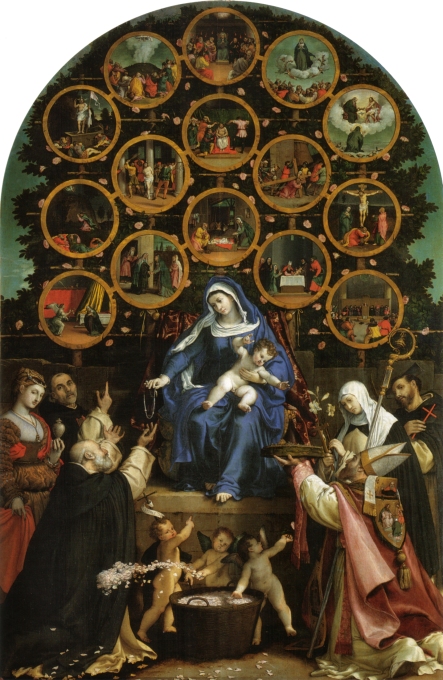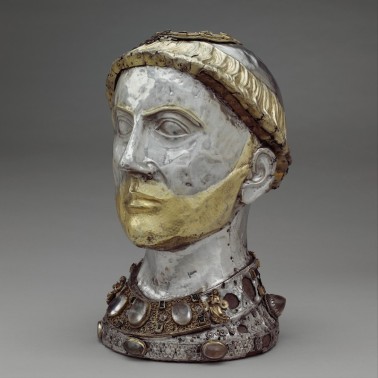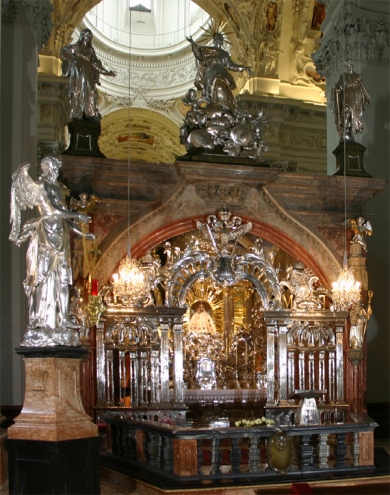
By Julie Hotchin and Claire Walker
Monastic cloisters provide fertile ground for exploring how emotions might be learned in a religious space designed and regulated to channel passions into an appropriate devotional relationship with the divine. Prayer and sacred rites to structure emotional arousal were performed in a sensory-stimulating environment, enhanced by the sound of music and repeated chanting, the smell of wax and incense, and the sight of holy images and objects. Artworks depicting Christ’s passion or the martyrdom of saints, ceremonies commemorating these events, and processions to shrines dedicated to suffering for the faith, encouraged nuns to actively engage with religious stories, to situate themselves within the scenes they contemplated and to feel the agony, grief and joy of redemption through pain and loss.
We can read about how religious women engaged with monastic materiality to cultivate religious feeling in the spiritual biographies of nuns who were revered as exceptionally holy by their sisters. In 1609, the English Carmelite Anne of the Ascension Worsely entered the monastic life ‘with resolution to doe and Suffer all for I apperhended [sic] fearfull things’, but conversely she ‘found all very Sweet and easy’ initially.[1]. This did not last and during her 34 years as a nun, Worsely’s initial intention to suffer was rewarded through forced separation from a beloved spiritual mentor, battles with the Carmelite friars, becoming prioress at a young age and the foundation of new convents. Significantly, it was her devotion to Christ, his passion, the Virgin Mary and St Teresa that assisted her through these difficulties, and the material dimensions of her spirituality were central to shaping and expressing her religious sentiments. Miraculous events surrounded her devotion to the Eucharist – Worsely had visions of Christ upon receiving it which comforted her: ‘I have feeling to his Blessed Humanity and in occasions remembler [sic] his meek and humble Carriage which doth move me not to be earnest in any thing.[2] The nuns reported sensing a ‘Sweet odour’ in her mantle when she received communion and, in the lead up to her death, the sound of the convent periodically being serenaded by the sound of heavenly choirs and musical instruments was said to be audible.[3] This report suggests the ability of the senses to trigger responses that provided spiritual consolation. The convent also received a revered image of Christ and his cross, executed on Worsley’s command. She had experienced such a vision of him during her sickly final years when he reputedly told her that before she died ‘she should feel something of what he Sufferd in that misstery’.[4] Her sisters venerated the picture long after her death because upon her deathbed, as Christ had foretold, the prioress was seized with a violent pain in her shoulder. Anne’s experience illustrates the potential of the body, ‘as the place where emotion happens’,[5] to express relationships to the divine, in both Anne and also her convent.

Other significant objects had a similarly miraculous provenance. During building work at the Antwerp Carmel monastery on a site revealed to Worsely in a vision of the Virgin Mary, the nuns uncovered ‘a very handsome Stone Image of our Blessd Lady above a yard high, with little Jesus in her Armes’.[6] Placed in a corridor within the Antwerp Carmelites’ living quarters, the community venerated it and would dedicate particular devotions to it in times of adversity; apparently with much success and the occasional miracle. The life of Anne of the Ascension Worsley and the history of her religious community were accordingly replete with signs of divine intervention and favour, manifested in the devotional objects, rituals and in the deep sense of comfort, hope and spiritual fulfillment they offered to the nuns.
A recent CHE symposium at The University of Adelaide on ‘Religious Materiality and Emotion‘ explored the role of the material in arousing and managing emotion in religious contexts (programme and abstracts here). Speakers at the symposium discussed a variety of ways through which people harnessed material forms to express, persuade and transform the emotional state of religious devotees through practices designed to amplify or diminish, arouse or redirect feelings in particular religious contexts.
As Anne of Ascension Worsely’s example shows, material objects and embodied experiences were central to the lived experience of religion by individual nuns and their communities. Attitudes towards the role of material culture (understood broadly as artefacts as well as ideas and practices in relation to artefacts) in producing religious feeling have had a chequered history. Traditions of scholarship that emphasised the role of faith and doctrine in generating religious feeling, or in dismissing the place of material aids to devotion in favour of more ‘elevated’ forms, remind us that the place of the material in cultivating emotion within religion is negotiated and culturally specific. Miri Rubin opened the symposium with a public lecture in which she traced an emotional arc of devotional practice centred on worship of the Virgin Mary in the Middle Ages. The lecture demonstrated the evolving relationship between material representations of the Virgin and spiritual trends which increasingly emphasised the human dimensions of Mary as an emotional model for devotees. Interested viewers can watch her keynote below.
Miri Rubin “The Virgin Mary: A History in Matter and Emotion”
Yet, the rejection of material things is itself an expression of attitudes towards the material and its role in arousing piety. As Kirk Essary showed in his paper on Erasmus’s counsel to preachers about stirring the emotions, advice about avoiding ‘excessive’ physical display and maintaining composed comportment so as to inspire appropriate feelings in the audience illustrates how reactions against materiality are nevertheless expressed through embodied forms. Similarly, in her keynote lecture, Monique Scheer explored how emotions function as material practices through a study of how feeling is instrumental to prayer in contemporary Protestant Churches in Germany. Her keynote generated lively debate about the relations between sensation and emotion, and how the body is authorised, or negated, as a medium for religious expression. Listen to her keynote here.

Speakers highlighted the diversity of ways through which images, sculpture, clothing and devotional aids such as rosary beads define spiritual identity, and are employed to cultivate religious feelings and express relationships – between beings, things and the sacred. The role of images in fostering desired religious sentiments is well documented, but what is it about the attributes of objects or their shape and substance that produces a desired emotional state? Lisa Beaven outlined how the practice of reciting the rosary in front of certain devotional images was intended to arouse and engage the senses (sight, sound, smell, touch) and thus intensify feeling. Likewise, the finely sculpted lifelike eyes and meticulously curled beards lent individuality to the early-thirteenth century reliquary busts discussed by Veronica Fitzpatrick. The ability of these details to draw in the viewer’s gaze suggests how an object’s material properties were calibrated to generate a particular affect. Sarah Randles explored how the materiality of wax influenced its use in emotional practices such as lighting candles and making seals. Wax is malleable, making it a particularly productive example through which to explore aspects of how objects acquired and conveyed emotional resonances.
The manipulation of objects and emotional practices within religious settings is designed to produce a desired emotional state. A devotee’s emotional responses were planned, often involving multiple material forms such as reading, posture and the use of images or devotional objects. In public settings, an individual’s emotional arousal could be directed by devotional objects and practices towards political ends. The role of confraternities in fifteenth-century Florence in calming prisoners prior to their execution, examined by Moira Kenny, for example, demonstrated how devotional imagery and religious texts were employed to cultivate a desired state of repentance and calm that reinforced political authority and social order. The selection, arrangement and use of material objects in communal settings, such as churches, played an important role in shaping the collective performance of emotion and harnessing it to assert political legitimacy. Charles Zika presented a wide-ranging keynote on the role of the pilgrimage site of Mariazell in Austria in transmitting complex emotions. His analysis showed how changing ornamentation and display at the site aimed to generate emotional responses which shaped local, religious and political identities.

The concluding discussion about the multiple ways in which material forms produce and shape emotions in religious settings focused attention on the question ‘what is a religious emotion?’ Any emotion can be religious as religious sentiment cannot be separated from ordinary structures of feeling. What makes an emotion religious, therefore, is that it occurs within a religious context and is integral to its social and symbolic relations.[7] That is, a religious emotion is not simply a matter of personal affect, but arises within the context of a community and is directed towards the individual’s relationship with the sacred. Thus Anne of the Ascension Worsely’s religiosity, grounded in her attachment to particular holy figures and expressed in her emotional engagement with objects, devotions and ritual dedicated to them, was both the product of her monastic lifestyle and in turn it shaped the devotional and emotional culture of her nuns. The role of materiality in cultivating emotional states that generate felt experiences of the sacred offers fruitful paths for future research.
Claire Walker is an Associate Investigator at The University of Adelaide. Claire is a scholar of early modern religion, gender and politics. She has written extensively about exiled English convents in France, the Southern Netherlands and Portugal in the 16th and 17th centuries.
Julie Hotchin is a Visitor in the School of History at the Australian National University and an Associate Investigator. Her research interests centre on religious women in medieval Germany, including women’s roles in manuscript production, use and exchange; religious materiality; and the role of emotions in devotional literature.
Further reading:
John Corrigan, ‘Religion and Emotions’, in Doing Emotions History, ed. Susan J. Matt and Peter N. Stearns (Urbana: University of Illinois Press, 2014), pp. 143–62.
John Kieschnick, ‘Material Culture’ in The Oxford Handbook of Religion and Emotion, ed. John Corrigan (Oxford: Oxford University Press, 2008), pp. 223–37.
References:
[1] ‘Short Colections of the Beginnings of Our English Monastery of Teresians in Antwerp with Some Few Perticulars of Our Dear Deceased Religious’ in Katrien-de Gelder (ed.), English Convents in Exile, 1600-1800, Vol. 4 Life Writing II (London: Pickering and Chatto, 2013), p 5.
[2] Short Colections, p. 18.
[3] Short Colections, p. 33.
[4] Short Colections, p. 32.
[5] Piroska Nagy, ‘Sharing Charismatic Authority by Body and Emotions: The Marvellous Life of Lukardis von Oberweimar (c. 1262–1309)’, in Mulieres Religiosae: Shaping Female Spiritual Authority in the Medieval and Early Modern Periods, ed. Veerle Fraeters and Imke de Gier (Turnhout: Brepols, 2014), p. 123.
[6] Short Colections, pp. 24–25.
[7] Ole Riis and Linda Woodhead, A Sociology of Religious Emotion (Oxford: Oxford University Press, 2010), p. 54.
